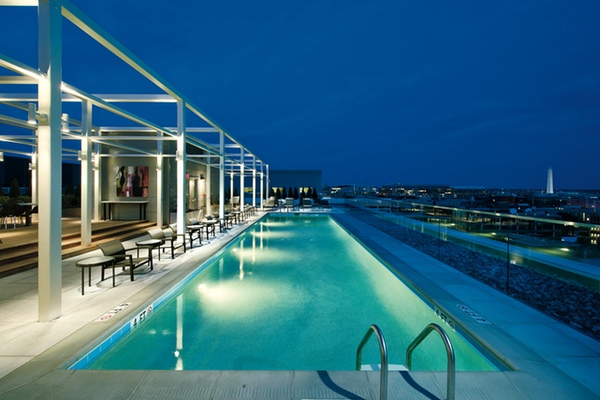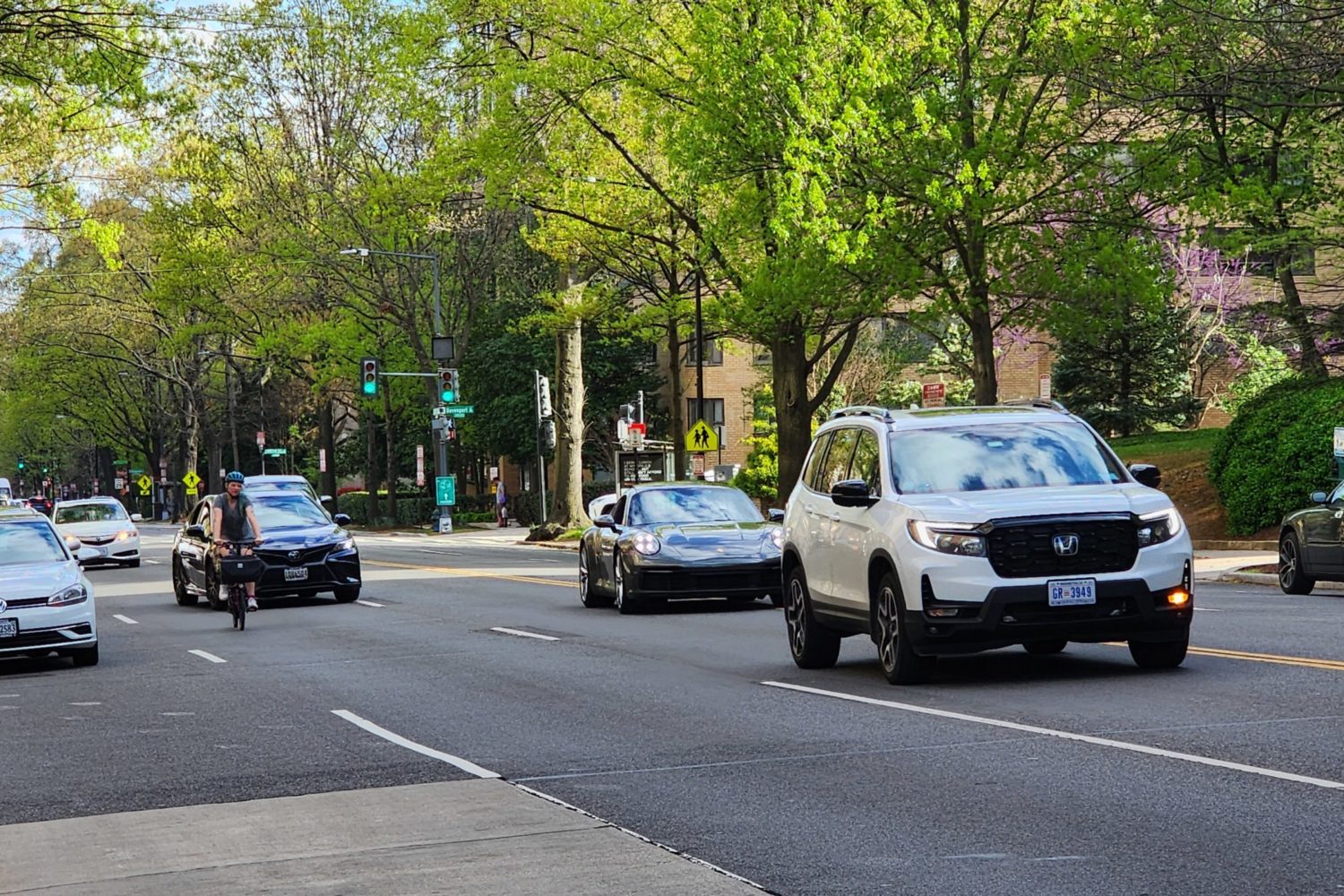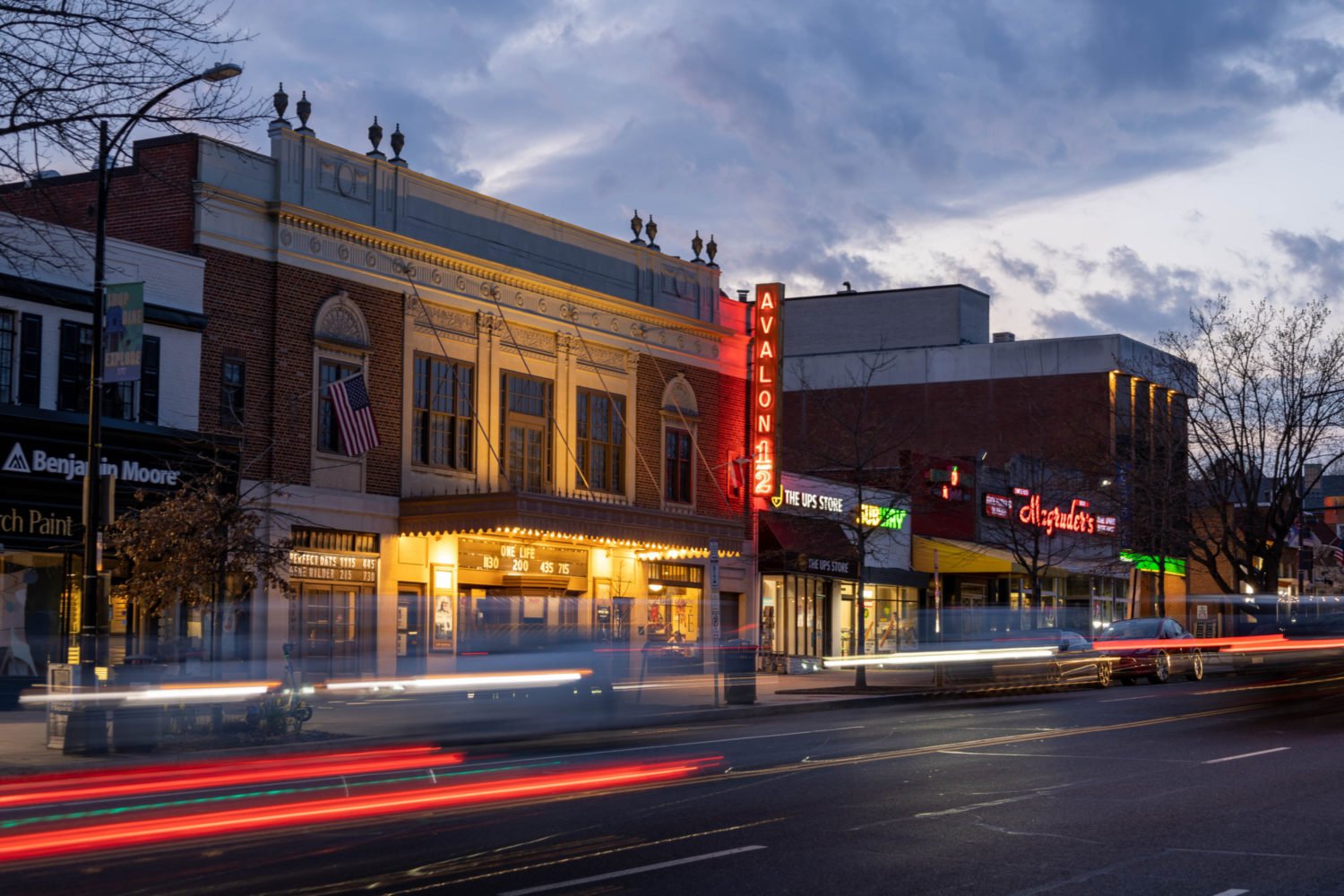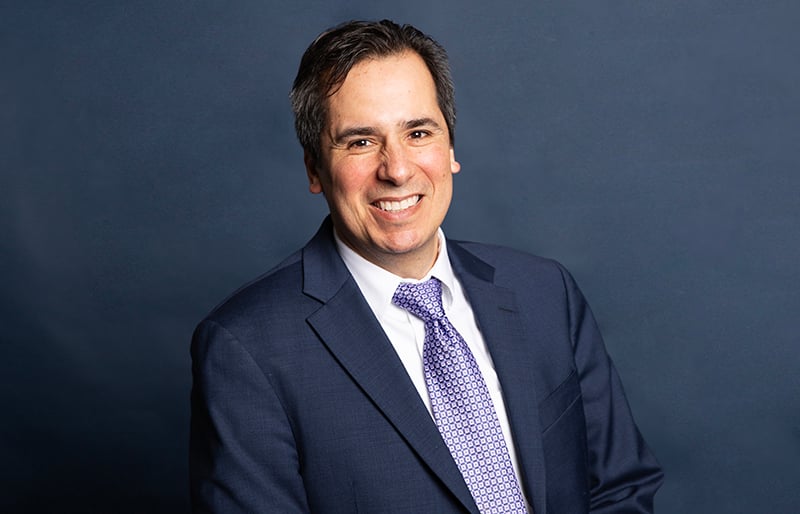The rooftop pool at Residences on the Avenue offers panoramic views of Washington. Photograph by Eric Taylor
When pediatrician Amanda Levin moved here from Chicago this past summer, she and her husband, Dave, an orthopedic surgeon, decided to skip house-hunting and instead rent a two-bedroom apartment at Upstairs at Bethesda Row.
“We wanted to make sure our jobs were working out and that the area was a good fit,” she says. “We didn’t want to be obligated to a house and then realize we wanted to move.”
The luxury apartment building, where two-bedrooms start at $3,200 a month, comes with parking, a patio, and easy access to nearby stores and parks. The Levins, who have a ten-month-old son, also like their short commutes to work.
The couple was hesitant to buy because they had been burned before by the housing market. Amanda Levin, 34, had owned a condo while in a medical residency in Ohio and sold it for a loss in 2008. They also own a condo in Indianapolis, where Dave used to live, which they haven’t been able to sell because of foreclosures in the building. As a result, Amanda says, “we’re a little skittish.”
Some potential buyers are like the Levins, wondering if buying a home is still a good investment. “People who previously would have bought are choosing not to buy,” says Cindy Clare, president of Kettler, a local property developer.
When you pair that sentiment with tighter lending requirements and new luxury apartment buildings, you end up with a strong rental market—monthly rents are up, vacancy rates are down, and lots of new rental buildings are in the pipeline. Says Brian Ridgway, president of Bethesda-based Executive Housing Consultants: “It’s a very good time to be a landlord in Washington, DC.”
One factor driving the apartment boom is that rental units are nicer than they used to be. Many new luxury apartments now feature amenities such as high-end appliances and floor-to-ceiling windows. “Potential condo buyers were saying, ‘I can get the same level of quality, and I don’t have to buy or provide more than a 12-month commitment,’ ” says Julie Smith, president of Bozzuto Management Company. “That pushed a lot of would-be buyers into the rental market.”
Grant Montgomery of Delta Associates, an Alexandria-based real-estate research firm, says the benchmark for apartment quality changed in 2006 when a glut of high-end condos were converted to apartments. “Prior to 2006, only a condo would have granite countertops and stainless steel. Now people expect it,” he says.
Amenities have become so important to luxury renters that while square footage of units is shrinking, common spaces are becoming plusher. In many new buildings, you’ll find movie theaters, yoga studios, rooftop pools, and private courtyards.
At the Alaire in Rockville, there’s a saline swimming pool and a “green” roof. The Reserve at Tysons Corner has saunas, an indoor basketball court, and a playground.
With perks such as 24-hour concierges, some new rental buildings sound more like hotels than apartments. At the renovated Kennedy-Warren in DC’s Woodley Park, staff members are available to feed cats and put food deliveries into fridges when owners are away. The building also helps organize yoga classes and book clubs.
But perhaps DC’s West End 25 has the most delicious perk of all—every afternoon, residents are treated to freshly baked cookies.
After selling their home in Georgia last fall, Rachel and Will Cagle moved to Washington for his three-year medical fellowship. Rather than looking for a new place to buy, the Cagles, who have a two-year-old-daughter, moved into a one-bedroom-plus-den at the Senate Square Towers on Capitol Hill.
Over the summer, Rachel and her daughter swam at the rooftop pool, and they often watch Disney movies in the building’s theater room, which has Bose surround sound. “I have a beautiful view of the Basilica [at Catholic University], a balcony, and beautiful floor-to-ceiling windows,” she says. “I couldn’t have afforded that if I bought.”
Ridgway notes that Washington’s somewhat transient population has helped fuel the rental boom: “A lot of people come to DC who work at the IMF, World Bank, embassies, or companies that bring people here for two or three years. It just doesn’t make sense for them to buy.”
Stephen Fuller, director of the Center for Regional Analysis at George Mason University, says the area’s high population of young professionals—who make a lot of money but may not have saved for a down payment—also plays a role. “They are knowledge workers who tend to be young and in an uncertain time in their lives,” says Fuller. “They want the flexibility to delay buying a house.”
Richard Stanfill, 28, moved to Washington from New Jersey six months ago. While he looks for a new job in marketing, he’s renting a two-bedroom, two-bath at the Gramercy at Metropolitan Park in Arlington with his girlfriend, a manager at Pentagon City mall.
Stanfill didn’t want to have to put down cash for a down payment, and he was drawn to the in-house gym, rooftop pool, and apartment balcony, from which he can see the US Air Force Memorial. “We knew we wanted to rent,” he says. “It’s not like I’m ready to invest.”
Seniors are also moving into Metro-accessible rentals. “We’re starting to see empty-nesters move in and say, ‘Wow, this is carefree living—I don’t have to do anything,’ ” says Julie Smith, referring to the on-site staff and services.
Rachel Cagle didn’t want to spend time mowing a lawn or shoveling snow, especially with her husband working such long hours: “You log your maintenance request online, and within 24 hours it’s taken care of.”
Another draw for renters is avoiding exposure to the housing market. The old saying that “renting is throwing money away” has been disproved by the housing bubble burst. “Attitudes towards buying homes have shifted in a more prudent direction,” says Martha Starr, associate professor of economics at American University. “Renting offers more protection against risk than buying,” she says, especially at the upper end of the market, which saw the steepest price drops.
Jeffrey Dillman, managing director at Atlantic Trust, where he advises high-net-worth clients, has long warned against buying residential real estate for investment reasons—and now his clients are much more likely to listen. “They used to think it was a no-brainer that you would buy property and make money,” he says. “The message that a house is just a home resonates more now.”
All of this increased demand has led to higher prices. According to Delta Associates, rents for luxury units in Washington rose by 5.6 percent over the last year, and concessions—in which owners offer incentives such as free rent for two months—fell from 4.1 percent of rent value in 2009 to 2.9 percent in 2010. Vacancy rates have also fallen.
Prices are particularly steep compared with the many deals offered in 2008 and 2009, when the housing bust caused a glut of rental units on the market.
That’s what happened to Lee Stuck, 25, a financial consultant who rented a two-bedroom unit with a roommate at View 14 near DC’s U Street, Northwest. The building offered two months of free rent along with luxury amenities including a rooftop deck and an in-house gym. On a prorated basis, that turned the normally $3,500 monthly rent into about $2,900—but only for the first year.
“I kind of naively thought that when the time came to sign our new lease, our rent would only go up 3 percent, but it went up 10 percent,” says Stu
ck. He and his roommate moved out after their first year.
Developers, on the other hand, have been pleased with the rise in demand and prices. While new construction halted in the wake of the downturn—one reason vacancy rates are down and prices have risen—new properties are now going up once again. According to Delta Associates, the number of planned rental units has been growing steadily since the end of 2009. About 31,000 units are now in the pipeline.
A slew of new luxury buildings will hit the market in the next few years, particularly in neighborhoods near Metro stops and employment hubs. “Renters want to be close to work first and foremost,” says Smith.
As for Amanda Levin, she says she wants to buy a home again—eventually. Meanwhile, renting in Bethesda is giving her a chance to get to know the neighborhoods, school systems, and public transportation.
“When we finally do buy, it will be the home we want to live in for the next 10 or 20 years,” she says. “We want to take our time.”
Next: Ten luxury buildings with units on the market
NOW LEASING
These ten luxury buildings opened to renters in January 2009 or later.
The Alaire
1101 Higgins Pl., Rockville
Rents in this 279-unit building start around $1,700 a month for a one-bedroom; two-bedrooms with lofts cost about $2,400 a month.
Allegro
3460 14th St., NW
In DC’s Columbia Heights, this building includes studios from $1,600 a month and penthouses with lofts for $4,000.
Archstone Wisconsin Place
4440 Willard Ave., Chevy Chase
Prices in this 432-unit building range from $2,200 for a studio to $3,900 for a two-bedroom, two-bath.
Lyon Place at Clarendon Center
1200 N. Garfield St., Arlington
This 244-unit building features a party room, lap pool, and fitness center. Rents range from $1,500 a month for a studio to $5,000 for a three-bedroom.
[Editor’s note: There is only one apartment available for rent at this time.]
The Metropolitan at Village at Leesburg
1500 Balch Dr., SE, Leesburg
Monthly rents start around $1,200 for a studio and go up to $2,500 for a three-bedroom. Amenities include an outdoor pool and screening room.
The Millennium at Metropolitan Park
1330 S. Fair St., Arlington
Prices range from $1,600 for studios to $7,390 a month for penthouses. The building has an outdoor pool, library, and salon.
North Bethesda Market
11351 Woodglen Dr., North Bethesda
The 400-unit building houses a new Whole Foods store and two swimming pools. Studios start around $1,700 a month, and the three-bedroom penthouse is about $4,800 a month.
The Reserve at Tysons Corner
8060 Crianza Pl., Vienna
This 476-unit building features an indoor basketball court and a playground. One-bedrooms start around $1,600 a month, two-bedrooms around $2,400.
Residences on the Avenue
2221 I St., NW
Prices in this 335-unit building, which has a yoga studio, range from $2,800 a month for a studio to $13,600 a month for a three-bedroom penthouse.
West End 25
1255 25th St., NW
This 283-unit building contains studios that rent for $2,500 and two-bedrooms that start at $4,800. The roof deck has a pool and party area.
This article appears in the October 2011 issue of The Washingtonian.


















